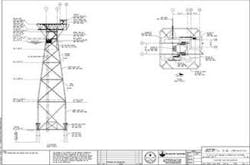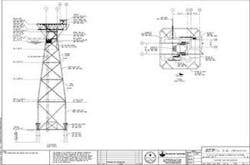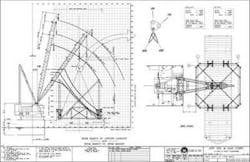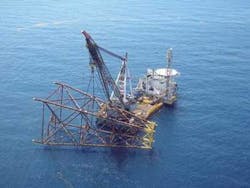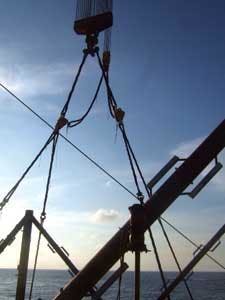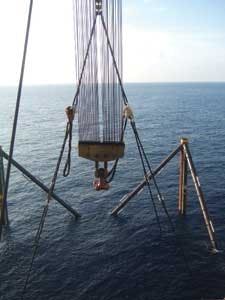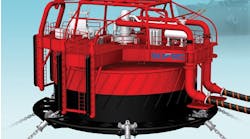R. M. Shivers III, ATP Oil & Gas
Lewis Grell, Bluewater Industries
Vikrant Joshi, James Hammock, J. Ray McDermott
Installation of an unconventional, two-piece jacket at the High Island A-589 A platform was carried out by J. Ray McDermott’sDB-50 in July 2007 for Bluewater Industries. High Island A-589 A is in the Gulf of Mexico about 80 nautical mi (148 km) south of Galveston, Texas, at a water depth of 477 ft (145 m). Due to water depth and installation equipment capability, the jacket was made in two sections. The lower section weighed approximately 1,550 tons (1,406 metric tons) and the upper section weighed approximately 1,680 tons (1,524 metric tons). The topside, also approximately 1,550 tons, was installed on the upper section of the jacket.
The lower section of the jacket was pinned to the sea floor with eight, 72-in. (183-cm) diameter skirt piles. Penetration varied between 170-180 ft (51.8-54.9 m) using underwater hydraulic hammers. The lower and upper section connections were grouted. All platform components were fabricated at Gulf Island Fabricators (GIF), in Houma, Louisiana.
Installation overview
The lower section of the jacket was transported offshore on a 400-ft (122-m) cargo barge. The rigging required to carry out the offshore lift was pre-installed on the lower jacket onshore at GIF. Once offshore, the cargo barge carrying the lower jacket was brought alongside the stern ofDB-50 with the help of a spacer barge. The lift rigging was connected to both the main and auxiliary blocks of the DB-50.
Initially, the jacket was lifted by the main block only; the auxiliary block had no load until in the water.
DB-50’s main block has the capacity for this lift, but is not rated for underwater operations. Its auxiliary block is capable of underwater operations, but has limited capacity. Thus, it was necessary to transfer the load to the auxiliary block from the main block without exceeding the auxiliary block’s capacity.
To allow sufficient time to transfer the load from the main block to the auxiliary block, the jacket was designed to float with void legs.
The jacket was lifted off the cargo barge with the main block and lowered into the water. At a pre-engineered stage, the main block stopped descending and the auxiliary block took over the load of the jacket. An ROV opened flood valves on the jacket legs. The simultaneous flooding and the lowering of the jacket were designed so that the load on the auxiliary block remained within its capacity.
The lift rigging components and complexity, in terms of sling angles, clearances, tri-plates and hook heights, are shown in this Lift Chart.
The unique rigging-flooding scheme and compatible jacket design facilitated load transfer from the main block to the auxiliary block.
After the jacket was positioned and oriented correctly, the skirt piles were installed using underwater hammers MHU270T and MHU500T, with the help of chaser piles. The ROV checked the level of the lower jacket with the Bullseyes that were on at each corner.
The annulus between the skirt pile and skirt pile sleeve was grouted. An ROV hot stabbed the primary grout connection on the skirt pile sleeve.
After grouting was completed, upper jacket installation began. The upper jacket was lifted by the main block ofDB-50’s crane. The jacket legs were flooded and the jacket was up-ended with the auxiliary block. The stabbing guides on the bottom of the upper jacket were made unequal in length to assist with the positioning into the lower jacket.
Dimensions of the top of the lower jacket and the bottom of the upper jacket were measured and monitored during fabrication to allow proper fit-up offshore. Two ROVs on monitored this operation. As a result of this planning, joining of the two jacket sections went smoothly.
The main block ofDB-50 lifting the lower jacket with the main block taking the entire load.
The annulus between the stabbing guides of the upper jacket and the lower jacket was grouted. The grout lines for this operation were run to the surface on the top of jacket.
On completion of the jacket related activities, deck, helideck and boat landing were also installed.
This project demonstrated the efficient use ofDB-50’s crane system in the underwater handling of a complex structure, such as the lower jacket, and also demonstrated underwater splicing of two sections of jacket, without diving support.
About the authors
R. M. Shivers III is vice president-Projects, ATP Oil & Gas; Lewis Grell is senior project manager, Bluewater Industries; Vikrant Joshi is project manager, J. Ray McDermott; and James Hammock is project engineer, J. Ray McDermott.
